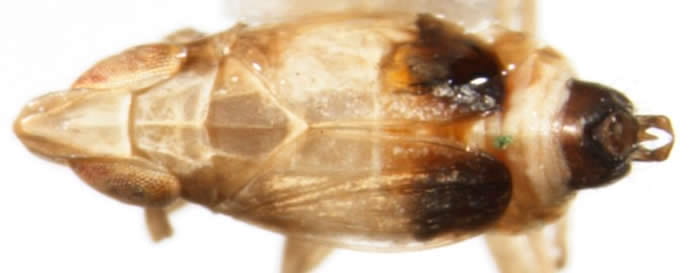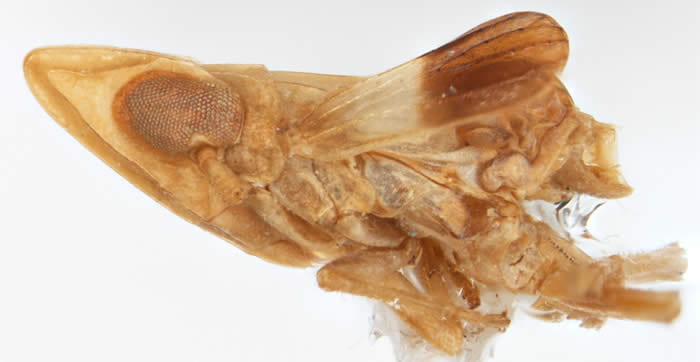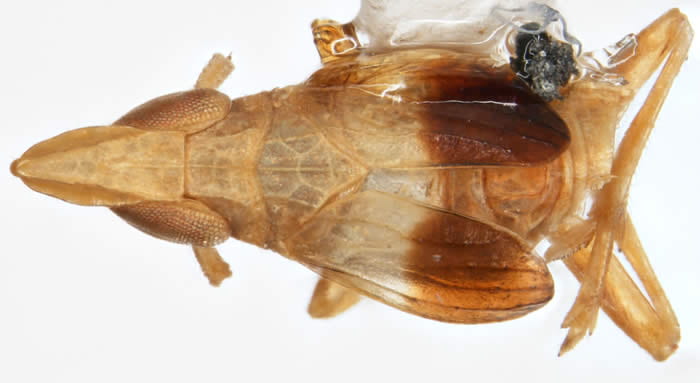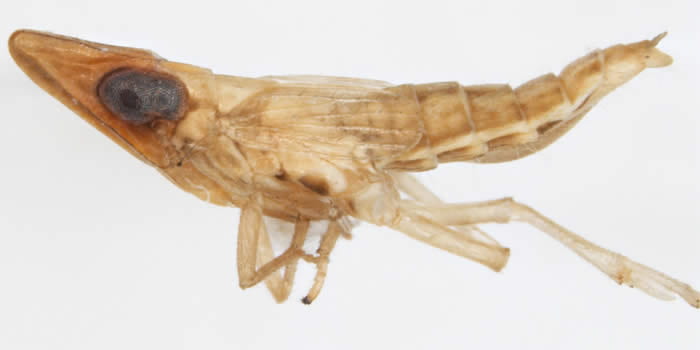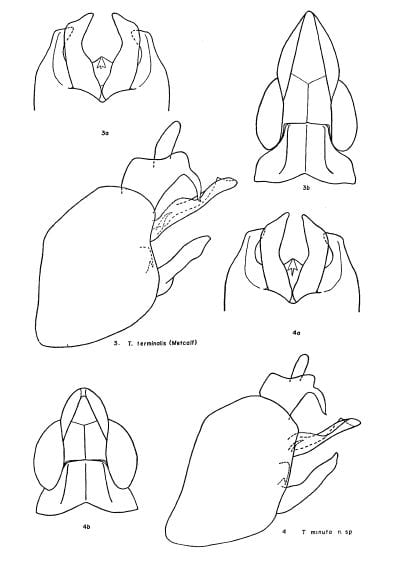[Back to Higher classification of Delphacidae]
Family Delphacidae Leach, 1815
Subfamily Delphacinae Leach, 1815
Tribe Delphacini Leach, 1815
Genus Tumidagena McDermott 1952
Distribution: East and Gulf coast of the US.
Type species: Tumidagena minuta McDermott, 1952.
Recognized species
Three valid species as follows:
Tumidagena minuta McDermott, 1952 – USA: Connecticut, Maryland, New Jersey, New York.
Tumidagena propinqua McDermott, 1952 – USA: Louisiana, Mississippi.
Tumidagena terminalis (Metcalf, 1923) – USA: Florida, North Carolina, Texas.
= Megamelanus terminalis Metcalf, 1923: 198-199.
= Tumidagena terminalis (Metcalf, 1923); comb. by McDermott 1952: 43.
Tumidagena minuta is the most northern species and T. propinqua and T. terminalis found in the southern parts of the genus range. Collectively these species can be expected to be found in salt marshes from southern New England to Florida and the Gulf Coast, probably including the Mexican Gulf Coast.
Plant associations:
All species in coastal marshes, expected to be Spartina feeders.
Tumidagena terminalis , Tumidagena minuta – Spartina patens (Aiton) Muhl. (saltmeadow cordgrass)
Economic Importance: Limited.
Recognition
Unusual, fragile appearing, pale species. Locally abundant in coastal marshes and ecological features noted in passing in a number of publications by Denno and colleagues (e.g., Raupp and Denno 1979, Denno 1980), although these publications primarily target Prokelisia spp. Macropterous forms unknown, but probably occur. All there species pale with dark markings at the end of the tegmina and a dark pygofer in males; females completely pale. Tumidagena minuta with a relatively short head, much longer in the remaining two species. The genus name Tumidagena reflecting the subtle lateral expansion of the head in front of the eyes in dorsal view.
Most similar to Neomegamelanus and Prokelisia, with which it shares the coastal marsh habitat, and is generally less often encountered. Superficially, the coloration of the males is distinctive. Tumidagena lacks the lateral carinae of the head (extending from the tope of the compount eye to the lateral carinae of the frons) that is found in Neomegamelanus. Prokelisia does not have the forward-projecting head, and brachypters have the wings extending to the time of the abdomen.
Apparently Tumidagena minuta overwinters as a 4th instar nymph (Denno 1977); Peterson et al. 2001 reported this genus to be ~99% short winged.
KEY TO RELATED GENERA [revised from McDermott, 1952]
1- Head acutely pointed in dorsal view; pronotum flared at lower margin … Neomegamelanus
1′- Head not acutely pointed in dorsal view; pronotum normal … 2
2- Head swollen in appearance; lateral carinae of head not strongly elevated … Tumidagena
2′- Head not acutely pointed or swollen in appearance; pentagonal or truncate in dorsal view … 3
3- Clypeus [frons] about one and one-half times as long as wide near apex, widest at middle; pygofer of males deeply notched at about level of genital styles; brachypterous forms with elytra extending to about third abdominal segment … Megamelanus
3′- Clypeus [frons] about two times as long as wide near apex, widest near apex; pygofer of males regular, not conspicuous by indentation of hind margin; elytra of brachypterous forms extending almost to or beyond end of abdomen … Prokelisoidea [now Prokelisia]
Key to the species of the genus Tumidagena modified from McDermott (1952)
1. Head length less than twice width at base … T. minuta
1′.- Head length at least twice width at base … 2
2. Head almost three times as long as width at base; aedeagus with a large fang-like spine at base on right side …. T. terminalis
2′.- Head slightly more than twice as long as width at base; aedeagus without a large fang-like spine at base on right side … T. propinqua
Tumidagena minuta (Photos by Kimberley Shropshire, UDEL)
Tumidagena propinqua (male, dissected)
Tumidagena terminalis from Florida (top male, bottom female)
Male left, female right
Figures from McDermott (1952)
Online resources.
3i.
EOL.
Bugguide.
Discover Life.
FLOW.
Hoppers of North Carolina.
Kunzweb Gallery.
American Insects.
BOLD.
GBIF.
Fauna Europaea.
Molecular resources:
Genbank has data for Tumidagena minuta (here). BOLD has data for Tumidagena minuta (as of 6 Aug 2018) (it appears to have been tagged T. terminalis, but from the photo it is clearly T. minuta.)
References
Bartlett, C. R. 2000. An annotated list of planthoppers (Hemiptera: Fulgoroidea) of Guana Island (British West Indies). Entomological News 111(2):120-132.
Bartlett, C. R., L. B. O’Brien and S. W. Wilson. 2014. A review of the planthoppers (Hemiptera: Fulgoroidea) of the United States. Memoirs of the American Entomological Society 50: 1-287.
Davis, L. V. and I. E. Gray. 1966. Zonal and seasonal distribution of insects in North Carolina salt marshes. Ecological Monographs 36(3): 275-295.
Denno, R. F. 1975. Wing polymorphism in salt marsh inhabiting Fulgoroidea. Journal of New York Entomological Society 83: 253-254. [notes wing polymorphism]
Denno, R. F. 1977. Comparison of the assemblages of sap-feeding insects (Homoptera-Hemiptera) inhabiting two structurally different salt marsh grasses in the genus Spartina. Environmental Entomology 6: 359-372. [Ecological notes]
Denno, R. F. 1980. Ecotope differentiation in a guild of sap-feeding insects on the salt marsh grass, Spartina patens. Ecology 61(3):702-714.
Denno, R. F., G. K. Roderick and K. L. Olmstead. 1991. Density-related migration in planthoppers (Homoptera: Delphacidae): the role of habitat persistence. American Naturalist 138(6): 1513-1541.
Kennedy, A. C., C. R. Bartlett and S. W. Wilson. 2012. An annotated checklist of the delphacid planthoppers (Hemiptera: Delphacidae) of Florida with the description of three new species and the new genus, Meristopsis. Florida Entomologist 95(2): 395-421.
Lago, P. K. and S. Testa III. 2000. The terrestrial Hemiptera and auchenorrhynchous Homoptera of Point Clear Island and surrounding marshlands, Hancock County, Mississippi. Journal of the Mississippi Academy of Sciences 45(3): 186-195
Leach, W. E. 1815a. Entomology. The Edinburg encyclopedia; conducted by David Brewster 9: 57-172. (family Delphacidae on p. 125)
McCoy, E. D. and J. R. Rey. 1981. Patterns of abundance, distribution, and alary polymorphism among the salt marsh Delphacidae (Homoptera: Fulgoroidea) of northwest Florida. Ecological Entomology 6(3): 285-291.
McDermott, B. T. 1952. A revision of the genus Megamelanus and its allies (Homoptera, Fulgoroidea, Delphacidae). Journal of the Kansas Entomological Society 25: 41-49.
Metcalf, Z. P. 1923a. A key to the Fulgoridae of Eastern North America with descriptions of new species. Journal of the Elisha Mitchell Scientific Society 38(3): 139-230, plus 32 plates. [from http://www.lib.unc.edu/dc/jncas/]
Metcalf, Z. P. 1943. General Catalogue of the Hemiptera. Fascicle IV, Fulgoroidea, Part 3, Araeopidae (Delphacidae). Smith College, Northhampton, Massachusetts.
Peterson, M. A., R. F. Denno and L. Robinson. 2001. Apparent widespread gene flow in the predominantly flightless planthopper Tumidagena minuta. Ecological Entomology, 26: 629–637. doi:10.1046/j.1365-2311.2001.00364.x
Raupp, M. J. and R. F. Denno. 1979. The influence of patch size on a guild of sap-feeding insects that inhabit the salt marshed grass Spartina patens. Environmental Entomology 8(3): 412-417.
Tsai, J. H. and F. W. Mead. 1982. Rotary net survey of homopterans in palm plantings in south Florida. Journal of Economic Entomology 75(5): 809-812.
Wilson, S. W. 2012. Tymbal morphology and co-occurrence of Spartina sap-feeding insects (Hemiptera: Auchenorrhyncha). Great Lakes Entomologist 45(3-4): 166-184.
Wilson, S. W. and J. E. McPherson. 1980. The distribution of the Fulgoroidea of the Eastern United States (Homoptera). Transactions of the Illinois State Academy of Science 73(4): 7-20.
Wolcott, G. N. 1950. The insects of Puerto Rico. [dated 1948]. Journal of Agriculture of the University of Puerto Rico 32(1): 1-224.


